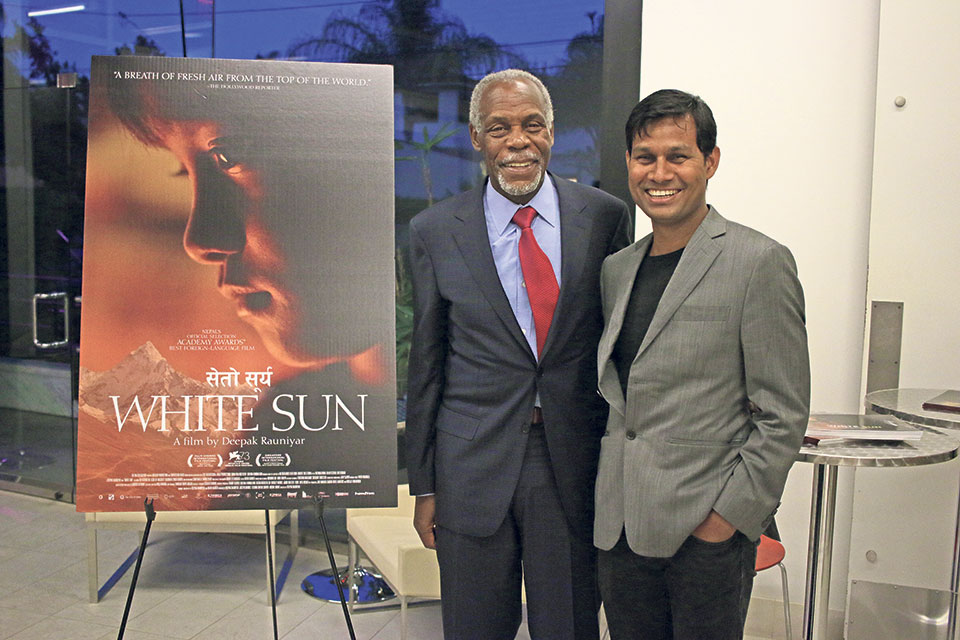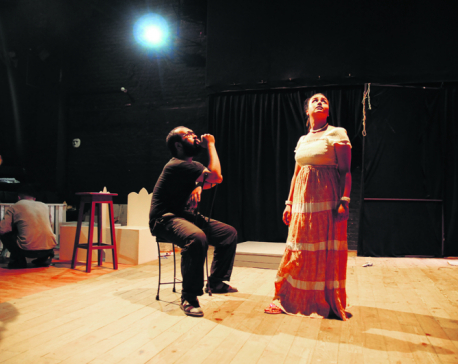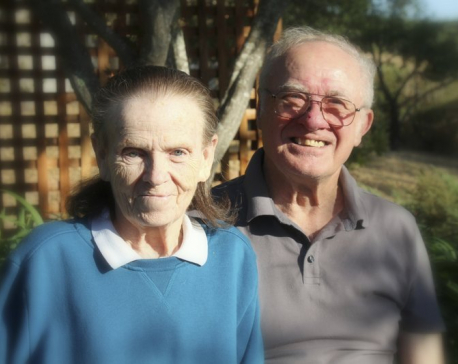
OR
Other side of conflict and the Oscar race
Published On: December 1, 2017 12:47 PM NPT By: Priyanka Gurung

Deepak Rauniyar’s second feature film, White Sun, maybe vying against other South Asian films for a spot as a nominee in Oscar’s foreign language category but the director himself is taking it easy in Morang right now.
“It’s mostly for personal reasons,” he says about the visit.
The last couple of months have been quite the whirlwind for him and his movie. From reviews in The New York Times to numerous international festival screenings and cinema releases, the director clearly has had his plate full. Though personally, Rauniyar says he is not done yet. He wants to re-release White Sun to reach more Nepali audience and, after much work, they have finally confirmed a date. White Sun is set to hit theaters in Kathmandu on December 8, 2017.
Here with The Week’s Priyanka Gurung he speaks about his movie making experience.
When did you settle on the storyline for this film?
The idea came back in 2009. I was working on a documentary and we met up with these two characters, both were injured during the insurgency but one was a Maoist guerilla and the other was from the Nepal army. It’s their conversation that inspired the movie. Even though they were involved in the same war, their perspectives on all that went down were drastically different. Rather than the fight, I wanted to show this, the impact the war has had.
The insurgency so far has inspired numerous novels, documentaries, interviews, newspaper articles – it’s been discussed a lot. Were you wary that the point of the movie might be redundant?
I definitely think it is time to move on. I think it’s time we stop dwelling on the pain and sorrow it has caused because wallowing about that and cursing the war aren’t fruitful. It’s not enough either because we are not going to get anything out of that. People have moved on as well. I wanted to focus on how we have adapted or are trying to adapt. Some of the type of characters we included in the movie wouldn’t be there if there had been no insurgency. I wanted to pick on inconspicuous things like these that is difficult to portray in news or literature.
They say when a movie connects with people and the masses it’s the best thing for a director. Do you feel like you have managed that?
I’m satisfied with how well the film has traveled abroad. It’s been a pleasant surprise. Even right now, 20 theaters in New Zealand are running the movie for the fourth week. We were recently able to release the film in 20 cities in Switzerland as well. Likewise, there have been many countries where we have screened it and the response has been good so far.
But we couldn’t reach the masses quiet as well in Nepal. It’s not that simple here because we haven’t been able to cultivate an audience for this kind of alternative movies. I knew this would be the case. They have never been a trend here. But either way, we are trying to work on it. That’s why we decided to re-release the movie.
When you are doubtful about how many people will actually see your movie, how do you keep your motivation up while working on it?
Basically, you can categorize filmmakers in two categories, there are those who want to make hits and develop stories that cater to the market. They write as well as produce in that manner. The other kind of filmmakers prioritizes the story that they want to bring to the screen. Its appeal to the market isn’t all that important. I obviously fall in the latter category.
It’s the reason I didn’t approach local investors while collecting funds for the movie. It would have been a lie if I told them that they would get returns of their investments. I relied on grants and foreign investors to finance this movie.
What about the other challenges of being a director? How do you inspire your actors and crew as well?
It’s different for every shooting. When you talk about the cast, I think you need to understand each actor’s personality. For me, it is important to understand their background, lifestyle, triggers because it is only after that that I can make them see my vision and evoke the emotions required for the scenes of the movie. This obviously takes time which is why we had started casting from the moment we started writing. I also emphasize a lot on the importance of workshops because it is there that we can discuss all these things.
I immensely enjoy the collaborative process while working on films. I prefer actors who have their own thoughts on the subject we are dealing with because then you can explore the possibilities more.
The script for me is a mere guideline – everything doesn’t have to go according to the lines written. For instance, the child actor’s line that everybody seems to like – “I’m a porter, not a human being” – wasn’t in the script. You get better results when everybody feels stimulated.
The audience seemed to really enjoy the child actors’ performance as well. How is it directing children?
It took us a long time to find them. As it is, there aren’t many child actors in Nepal but we held auditions, we scoured through various villages and we had already spent months by the time we actually met the kid that plays Amit. Coincidentally, as it happened, his life was similar to our character. He had lost his father, he had been a porter, had experience working for money, and so we didn’t have to explain the depths of his character. In many ways, he already knew what it was.
While we were filming, he wasn’t good at taking directions though. You couldn’t instruct him but when you explained the scenario, he could play the part. Pooja, on the other hand, needed rehearsals. If you gave her instructions, she could act well. The same goes for other kid actors as well. You just have to find out their triggers.
Many directors talk about how they become obsessed with the story of their films. Was that the case with you too?
Well, as I mentioned, the idea came around 2009 and we officially started writing White Sun in 2012. If somebody takes more than five years to develop a story, he surely is obsessed with it.
You think about ways to develop your characters and the arc of the story every day. Putting your ideas across with ease takes time and a lot of thought. Then we had to build the circumstances around the characters of the film. We spent months traveling to villages across the country to find the right house, the right backdrop for the story. It’s the details that build the depths of the characters and the story.
It’s worth obsessing over these things though because I have come across audiences who have caught on these little efforts. When they pick on the subtle meanings, the metaphors, it’s really something.
Having to juggle all these responsibilities can’t be easy. Then there is the fact that you have to lead the team too. How do you find this leadership role?
It can be overwhelming at times. You are also overworked. You are the first to wake up and the last to sleep. There are always so many decisions to be made. You have to tackle unexpected changes in plans, take care of the logistics, the finances, and it’s not a small operation. You are
spending a lot of money every day. Also, I’m not somebody who likes to impose their director status and shout and scream orders. But I have found this can be tricky. At times, the crew isn’t as efficient as you would like them to be but, then again, you learn with every experience. You learn to roll with the punches. And what’s more, with filmmaking each experience is new. You always have things to look forward to.
You May Like This

The other side of Hamlet
Laughs and punch lines aren’t exactly what you expect going into the staging of Hamlet, one of the greatest tragedies... Read More...

Older couples die together or cling to each other in fires
Some had just celebrated marriages of half a century or longer. They spent their time volunteering and playing with grandchildren.... Read More...

Mortality among migrant workers same as for other Nepalis: ILO report
KATHMANDU, Sept 20: The death rate among migrant workers is similar to that of the Nepali population for the same age... Read More...

Just In
- Indians vote in the first phase of the world’s largest election as Modi seeks a third term
- Kushal Dixit selected for London Marathon
- Nepal faces Hong Kong today for ACC Emerging Teams Asia Cup
- 286 new industries registered in Nepal in first nine months of current FY, attracting Rs 165 billion investment
- UML's National Convention Representatives Council meeting today
- Gandaki Province CM assigns ministerial portfolios to Hari Bahadur Chuman and Deepak Manange
- 352 climbers obtain permits to ascend Mount Everest this season
- 16 candidates shortlisted for CEO position at Nepal Tourism Board






_20220508065243.jpg)










Leave A Comment